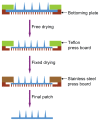A scalable fabrication process of polymer microneedles
- PMID: 22457598
- PMCID: PMC3310406
- DOI: 10.2147/IJN.S28511
A scalable fabrication process of polymer microneedles
Abstract
While polymer microneedles may easily be fabricated by casting a solution in a mold, either centrifugation or vacuumizing is needed to pull the viscous polymer solution into the microholes of the mold. We report a novel process to fabricate polymer microneedles with a one-sided vacuum using a ceramic mold that is breathable but water impermeable. A polymer solution containing polyvinyl alcohol and polysaccharide was cast in a ceramic mold and then pulled into the microholes by a vacuum applied to the opposite side of the mold. After cross-linking and solidification through freeze-thawing, the microneedle patch was detached from the mold and transferred with a specially designed instrument for the drying process, during which the patch shrank evenly to form an array of regular and uniform needles without deformation. Moreover, the shrinkage of the patches helped to reduce the needles' size to ease microfabrication of the male mold. The dried microneedle patches were finally punched to the desired sizes to achieve various properties, including sufficient strength to penetrate skin, microneedles-absorbed water-swelling ratios, and drug-release kinetics. The results showed that the microneedles were strong enough to penetrate pigskin and that their performance was satisfactory in terms of swelling and drug release.
Keywords: ceramic mold; polymer microneedles; polyvinyl alcohol; swelling.
Figures









Similar articles
-
Study on the fabrication and characterization of tip-loaded dissolving microneedles for transdermal drug delivery.Eur J Pharm Biopharm. 2020 Dec;157:66-73. doi: 10.1016/j.ejpb.2020.10.002. Epub 2020 Oct 12. Eur J Pharm Biopharm. 2020. PMID: 33059004
-
Multilayered pyramidal dissolving microneedle patches with flexible pedestals for improving effective drug delivery.J Control Release. 2017 Nov 10;265:113-119. doi: 10.1016/j.jconrel.2016.08.031. Epub 2016 Aug 26. J Control Release. 2017. PMID: 27574991
-
Poly (vinyl alcohol) microneedles: Fabrication, characterization, and application for transdermal drug delivery of doxorubicin.Eur J Pharm Biopharm. 2018 Aug;129:88-103. doi: 10.1016/j.ejpb.2018.05.017. Epub 2018 May 22. Eur J Pharm Biopharm. 2018. PMID: 29800617
-
Panorama of dissolving microneedles for transdermal drug delivery.Life Sci. 2021 Nov 1;284:119877. doi: 10.1016/j.lfs.2021.119877. Epub 2021 Aug 10. Life Sci. 2021. PMID: 34384832 Review.
-
Preparation, properties and challenges of the microneedles-based insulin delivery system.J Control Release. 2018 Oct 28;288:173-188. doi: 10.1016/j.jconrel.2018.08.042. Epub 2018 Sep 3. J Control Release. 2018. PMID: 30189223 Review.
Cited by
-
Manufacturing Process of Polymeric Microneedle Sensors for Mass Production.Micromachines (Basel). 2021 Nov 5;12(11):1364. doi: 10.3390/mi12111364. Micromachines (Basel). 2021. PMID: 34832776 Free PMC article.
-
Progress in Microneedle-Mediated Protein Delivery.J Clin Med. 2020 Feb 17;9(2):542. doi: 10.3390/jcm9020542. J Clin Med. 2020. PMID: 32079212 Free PMC article. Review.
-
Acid-Treated Water-Soluble Chitosan Suitable for Microneedle-Assisted Intracutaneous Drug Delivery.Pharmaceutics. 2019 May 2;11(5):209. doi: 10.3390/pharmaceutics11050209. Pharmaceutics. 2019. PMID: 31052596 Free PMC article.
-
Dissolving Polymer Microneedles for Transdermal Delivery of Insulin.Front Pharmacol. 2021 Sep 22;12:719905. doi: 10.3389/fphar.2021.719905. eCollection 2021. Front Pharmacol. 2021. PMID: 34630098 Free PMC article.
-
Fabrication and Evaluation of Dissolving Hyaluronic Acid Microneedle Patches for Minimally Invasive Transdermal Drug Delivery by Nanoimprinting.Gels. 2025 Jan 23;11(2):89. doi: 10.3390/gels11020089. Gels. 2025. PMID: 39996632 Free PMC article.
References
-
- Henry S, McAllister DV, Allen MG, Prausnitz MR. Microfabricated microneedles: a novel approach to transdermal drug delivery. J Pharm Sci. 1998;87(8):922–925. - PubMed
-
- Prausnitz MR. Microneedles for transdermal drug delivery. Adv Drug Deliv Rev. 2004;56(5):581–587. - PubMed
-
- Bartus RT, Tracy MA, Emerich DF, Zale SE. Sustained delivery of proteins for novel therapeutic products. Science. 1998;281(5380):1161–1162. - PubMed
-
- Wilke N, Mulcahy A, Ye SR, Morrissey A. Process optimization and characterization of silicon microneedles fabricated by wet etch technology. Microelectron J. 2005;36(7):650–656.
-
- Chabri F, Bouris K, Jones T, et al. Microfabricated silicon microneedles for nonviral cutaneous gene delivery. Br J Dermatol. 2004;150(5):869–877. - PubMed
MeSH terms
Substances
LinkOut - more resources
Full Text Sources
Other Literature Sources
Miscellaneous

